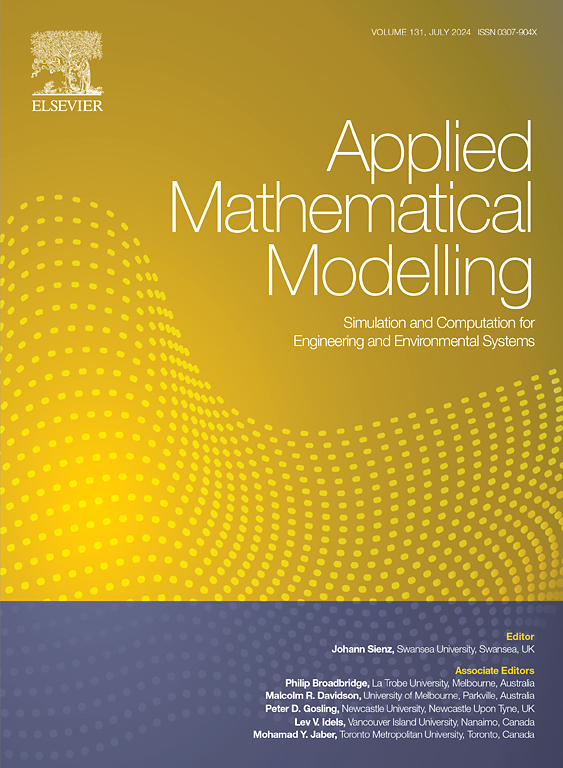Layout optimization of pore microstructure in fluid-saturated porous media using Galerkin decoupling technology and independent continuous mapping method (GDT-ICM)
IF 4.4
2区 工程技术
Q1 ENGINEERING, MULTIDISCIPLINARY
引用次数: 0
Abstract
A layout optimal design method combining Galerkin decoupling technology and an independent continuous mapping method (GDT-ICM) is proposed to rearrange the layout of pore microstructure. Firstly, the Galerkin decoupling technology (GDT) is employed to solve the Brinkman equation for fluid flow in fluid-saturated porous media, which integrates the Stokes equation and Darcy's law. Within this framework a self-programmable element balance equation is developed. Secondly, a permeability interpolation function is defined for each element, incorporating the permeability of the fluid and pore microstructure. This function distinguishes strictly between the fluid domain and the pore domain. Pore microstructures with arbitrary shape including permeability information are established in an Euler mesh by introducing the Carman-Kozeny equation, shape functions, the Joukowski mapping and filter functions (a modified arctan mapping function and the MATLAB inpolygon function) based on the ICM method. Thirdly, a layout optimization model aiming at minimizing energy dissipation is established to accomplish the optimal distribution of pore microstructures. A sensitivity analysis is performed with respect to design variables and the optimal model is solved by a genetic algorithm. Numerical results demonstrate that the proposed method is effective and feasible in 2D-space. The maximum velocity within the fluid field is reduced by 45 %, and the issue of localized high pressure occurring around the pore is resolved. This paper provides guidance for solving the Brinkman coupled equation and the layout optimization of the microstructure in porous media.
利用伽勒金解耦技术和独立连续映射法(GDT-ICM)优化流体饱和多孔介质中的孔隙微结构布局
提出了一种结合Galerkin解耦技术和独立连续映射法(GDT-ICM)的布局优化设计方法,用于重新布置孔隙微结构。首先,采用 Galerkin 解耦技术(GDT)求解流体饱和多孔介质中的布林克曼方程,该方程综合了斯托克斯方程和达西定律。在此框架内,开发了一个可自行编程的元素平衡方程。其次,为每个元素定义了渗透率插值函数,其中包含流体和孔隙微结构的渗透率。该函数严格区分流体域和孔隙域。通过引入 Carman-Kozeny 方程、形状函数、Joukowski 映射和基于 ICM 方法的滤波函数(改进的 arctan 映射函数和 MATLAB inpolygon 函数),在欧拉网格中建立了包含渗透率信息的任意形状孔隙微结构。第三,建立了一个以能量耗散最小化为目标的布局优化模型,以实现孔隙微结构的最优分布。对设计变量进行了敏感性分析,并通过遗传算法求解了优化模型。数值结果表明,所提出的方法在二维空间中是有效和可行的。流体场内的最大速度降低了 45%,孔隙周围出现局部高压的问题也得到了解决。本文为多孔介质中布林克曼耦合方程的求解和微观结构的布局优化提供了指导。
本文章由计算机程序翻译,如有差异,请以英文原文为准。
求助全文
约1分钟内获得全文
求助全文
来源期刊

Applied Mathematical Modelling
数学-工程:综合
CiteScore
9.80
自引率
8.00%
发文量
508
审稿时长
43 days
期刊介绍:
Applied Mathematical Modelling focuses on research related to the mathematical modelling of engineering and environmental processes, manufacturing, and industrial systems. A significant emerging area of research activity involves multiphysics processes, and contributions in this area are particularly encouraged.
This influential publication covers a wide spectrum of subjects including heat transfer, fluid mechanics, CFD, and transport phenomena; solid mechanics and mechanics of metals; electromagnets and MHD; reliability modelling and system optimization; finite volume, finite element, and boundary element procedures; modelling of inventory, industrial, manufacturing and logistics systems for viable decision making; civil engineering systems and structures; mineral and energy resources; relevant software engineering issues associated with CAD and CAE; and materials and metallurgical engineering.
Applied Mathematical Modelling is primarily interested in papers developing increased insights into real-world problems through novel mathematical modelling, novel applications or a combination of these. Papers employing existing numerical techniques must demonstrate sufficient novelty in the solution of practical problems. Papers on fuzzy logic in decision-making or purely financial mathematics are normally not considered. Research on fractional differential equations, bifurcation, and numerical methods needs to include practical examples. Population dynamics must solve realistic scenarios. Papers in the area of logistics and business modelling should demonstrate meaningful managerial insight. Submissions with no real-world application will not be considered.
 求助内容:
求助内容: 应助结果提醒方式:
应助结果提醒方式:


